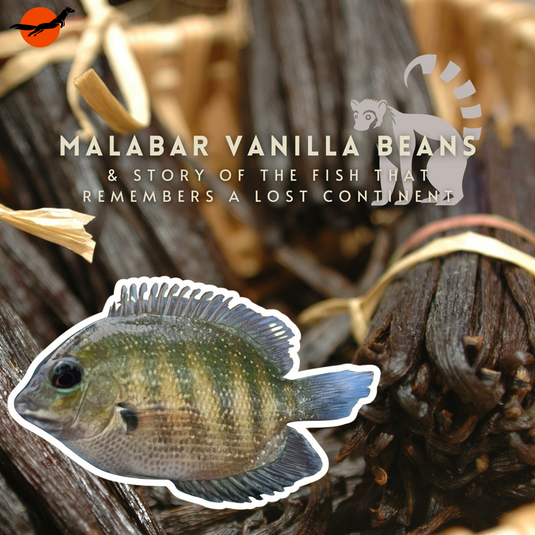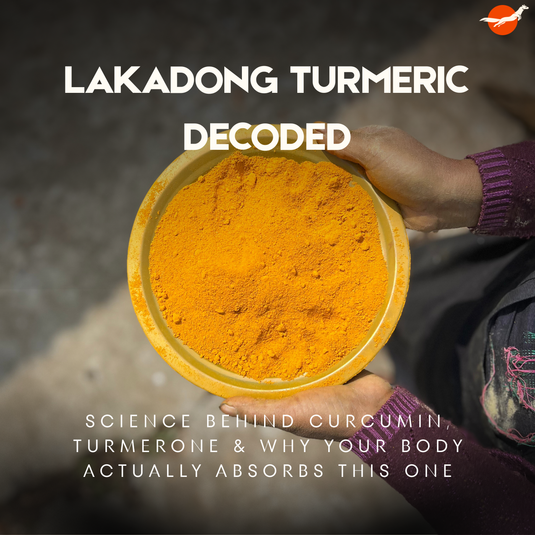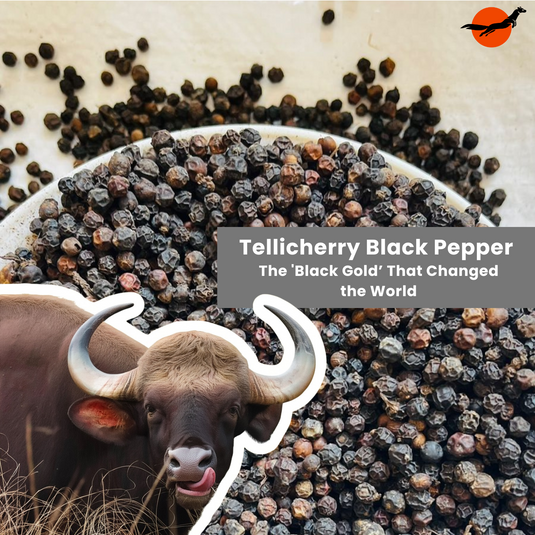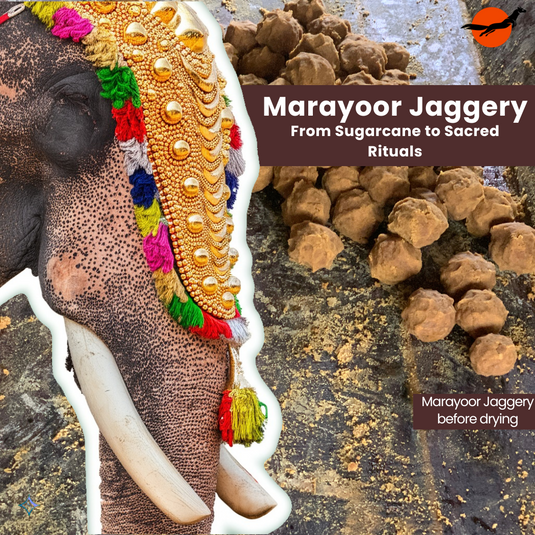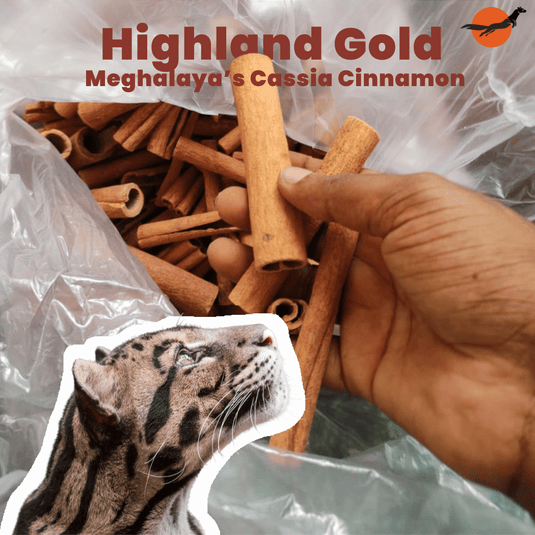In this article, we use Malabar Vanilla, Kerala Vanilla, and Indian Vanilla interchangeably to refer to the same product.
What on earth could Vanilla Beans have to do with a fish from Kerala? And how does Madagascar enter this story? It turns out the Green Chromide fish, locally known as Karimeen in Kerala, has long-lost cousins in Madagascar’s waters, a connection beautifully illustrated in Pranay Lal’s book Indica: A Deep Natural History of the Indian Subcontinent. This curious connection isn’t a mere coincidence; it’s a clue from deep time. It’s a tale of drifting continents and split ecosystems, and it sets the stage for an even more flavorful connection between Kerala and Madagascar: Vanilla.
Let’s unravel this fascinating story. Over 88 million years ago, India and Madagascar were joined at the hip as part of the supercontinent Gondwana. When they broke apart, they left behind telltale signs – like a gap in the Western Ghats of South India and shared species separated by an ocean. This ancient link bridges geology, climate, and biology, ultimately bringing us to the lush forests of Kerala and the vanilla vines that thrive there just as they do in Madagascar. The Gondwana connection isn’t just a chapter in a science textbook; it’s a living saga that makes Kerala’s terroir surprisingly similar to Madagascar’s. And that is delicious news for vanilla lovers.
The Gondwana Connection: When Kerala and Madagascar Were One
To understand why Malabar Kerala vanilla can rival the famed Madagascar vanilla, we need to go back to when Kerala and Madagascar were joined together. In the age of Gondwana (the southern supercontinent that existed over 150 million years ago), the land that is now India (including Kerala) was attached to East Africa and Madagascar. Geologists note that the Western Ghats mountain range of India and the central highlands of Madagascar were once a continuous landmass. Around 88 million years ago, a massive volcanic event (the Marion Hotspot) wrenched India and Madagascar apart, splitting the Indian plate and creating the Palakkad Gap in the Western Ghats. If you look at a map today, the coastline of Madagascar fits like a jigsaw piece against India’s southwest coast – a visual reminder of their prehistoric fit.
Nilgiri Marten grows its Kerala Vanilla in the lush Western Ghats along the Malabar coast. This is the same land that once split from Madagascar, giving rise to what we now call Malabar Vanilla beans.
This breakup had profound effects on life and climate. For one, it isolated populations of plants and animals on either side. That’s why we find related species in Kerala and Madagascar despite the vast ocean between them. (The Green Chromide fish or Karimeen is one example – its cousins in Madagascar evolved separately for 88 million years after the land split!) As a Medium science writer quipped, “the flora and fauna of Madagascar show a closer affinity to India than to Africa,” thanks to this ancient link. In other words, Madagascar’s ecosystem has more in common with Kerala’s than with neighboring Africa’s. Both regions inherited tropical climates and similar soils from their Gondwanan past.
This dramatic origin story not only makes for a fun bit of trivia but also underpins why Kerala and Madagascar share such lush, green environments ideal for growing spices like vanilla.
Twin Ecosystems: Kerala and Madagascar’s Shared Climate and Biodiversity
Separated by thousands of kilometers, Kerala (in southwestern India) and Madagascar (off Africa’s east coast) might seem worlds apart. Yet their environments are strikingly similar in many respects – a legacy of their time together in Gondwana. Both are blessed with hot, humid tropical climates with abundant rainfall, fertile soils, and dense greenery. Kerala’s climate is defined by heavy monsoon rains (2000–3000 mm annually in many areas) and warm temperatures around 25–30 °C – conditions that vanilla orchids love.
Madagascar’s vanilla-growing regions, especially the northeast SAVA region, are likewise tropical and wet, with humid rainforests and warm weather moderated by the Indian Ocean. In essence, both Kerala and Madagascar offer the warm, moist, climate and well-drained soils that vanilla needs to thrive. It’s no surprise that vanilla vines feel right at home in Kerala’s Western Ghats just as they do in Madagascar’s jungles.
Madagascar’s life evolved in isolation, much as Kerala’s did in its lush corner. Yet, remarkably, some plant families and lineages are shared, remnants of the ancient Gondwana forest. For example, both regions are rich in orchids (vanilla itself is a type of orchid) and spices. Kerala is historically known as the spice coast (home of black pepper, cardamom, cinnamon, etc.), and Madagascar today is world-famous for spices like vanilla and cloves.
Both landscapes support agroforestry – mixed farms where pepper vines, coffee bushes, or vanilla orchids grow under the canopy of taller trees. In short, Kerala and Madagascar are like ecological cousins – separated by the sea but nurtured by similar rain, sun, and rich earth. This kinship sets the stage for a flavorful coincidence: the cultivation of world-class vanilla in both places.
Vanilla’s Journey: From Mesoamerica to Kerala and Madagascar
Vanilla is not originally from either Kerala or Madagascar – it’s native to the rainforests of Mexico and Central America. So how did it become the pride of Madagascar and find its way to Kerala? This journey is a tale of exploration, innovation, and the search for the best vanilla in the world.
For centuries, vanilla orchids grew wild in Mexico, pollinated by native bees and treasured by the Aztecs for flavoring chocolate. The French introduced vanilla cultivation to Réunion (then Île Bourbon) and Madagascar in the mid-1800s. By the late 19th century, Madagascar (along with Réunion and the Comoros) was producing a majority of the world’s vanilla and had given rise to the famous “Bourbon vanilla” variety (named after Bourbon island, the old name of Réunion). Madagascar’s climate proved ideal, and to this day, “Madagascar Bourbon vanilla” is synonymous with premium quality vanilla beans.
Lesser known is that vanilla reached India (Kerala and neighboring states) around the same time or even earlier than it reached Madagascar. Historical notes suggest vanilla vines were introduced to India by Europeans in the 1830s–1840s.
By the early 2000s, hundreds of farmers in Kerala’s hill districts (Wayanad, Idukki, Kottayam, etc.) had planted vanilla orchids under the shade of coconut palms and rubber trees, hoping these “green gold” vines would bring wealth. The government’s Spices Board noted that by the late 1990s, India had about 1,000 hectares under vanilla cultivation, with Kerala leading the way.
Both in Madagascar and Kerala, vanilla is grown in remarkably similar ways – a testament to their shared tropical conditions. Vanilla vines flourish in tropical forests, as seen here with plump green vanilla pods clinging to a support tree. Kerala and Madagascar both provide the warm, humid climate and dappled shade that these vanilla orchids need to thrive.
Vanilla cultivation techniques in Kerala and Madagascar are nearly identical: hand-pollination, careful harvesting, and patient curing. Where they differ is scale and history – Madagascar’s vanilla industry is massive and generations old, whereas Kerala’s vanilla farming is more boutique and recent. But as we’ll see next, when it comes to flavor and quality, Kerala vanilla can stand toe-to-toe with Madagascar’s vaunted Bourbon vanilla.
Kerala Malabar Vanilla vs. Madagascar Vanilla: Flavor Profile and Quality
Madagascar’s Bourbon vanilla has earned a reputation as the best vanilla in the world – famous for its rich, creamy, and full-bodied flavor with notes often described as sweet, smooth, and rum-like. Chefs worldwide prize Madagascar vanilla beans for their high vanillin content and aromatic punch that shines in ice creams, custards, and bakes. Given this fame, you might wonder: can vanilla from Kerala, India, possibly measure up to this gold standard? The answer from experts and blind taste tests is a resounding yes.
The flavor profile of high-quality Indian (Kerala) vanilla is very similar to its Bourbon cousins across the Indian Ocean. After all, they are the same species (Vanilla planifolia) grown in analogous environments. Indian vanilla tends to have a sweet, creamy flavor with a hint of smokiness or nuttiness, very much in line with Bourbon vanilla notes. Chefs who have worked with Kerala vanilla often rave about its quality.
From a flavor chemistry perspective, it makes sense. The vanillin content of Indian vanilla is comparable to that of Bourbon vanilla. Well-cured Kerala beans are plump and oily, with an intoxicating aroma composed of hundreds of compounds, just like Madagascar beans.
It’s worth noting that vanilla’s flavor profile can vary slightly with terroir and curing technique. Some say Madagascar vanilla has a creamy, sweet profile with hints of dried fruit and rum, while Indian vanilla might have a touch more smokiness or a chocolatey note. But these nuances are subtle. Fundamentally, a high-grade Kerala vanilla bean will impart the same luxurious, sweet-spicy perfume that makes real vanilla an irreplaceable ingredient. And because Kerala’s farmers often intercrop vanilla with spices like pepper and cardamom, the vanilla picks up spice undertones from its environment.
Why Kerala Vanilla Stands Tall
- Geographical Similarities: Both regions share lateritic soils, high humidity, and stable tropical temperatures.
- Curing Processes: Traditional sun-drying and sweating methods passed down by local cultivators yield beans with 1.5 - 2% vanillin, on par with premium Madagascan grades.
- Sustainability & Fair Trade: Kerala’s smallholder cooperatives embrace organic practices and equitable pricing, mirroring emerging sustainability initiatives in Madagascar.
Global Perception and Marketing: Madagascar vs. Kerala Vanilla
Despite their comparable quality, Madagascar vanilla and Kerala vanilla have vastly different profiles in the global market. Madagascar is the titan of vanilla. This single island produces 70–85% of the world’s natural vanilla supply. For decades, “Madagascar Bourbon Vanilla” has been the gold standard for buyers, and the country’s entire northeastern economy revolves around vanilla exports. In 2017, for example, Madagascar’s dominance (and a bad cyclone) led to a global shortage that sent vanilla prices to record highs.
Kerala (and India in general), on the other hand, is a minor player in volume. India produces only a few tonnes of vanilla annually (some 6–8 tons according to mid-2010s figures). For years, Indian vanilla wasn’t widely known internationally; even within India, natural vanilla was rare in kitchens until the mid-2000s. Synthetic vanillin essence had dominated the market because it’s 20 times cheaper, and most consumers didn’t know what real vanilla tasted like. This meant Kerala’s vanilla farmers struggled for recognition.
However, the narrative is changing, thanks to chefs, artisanal food producers, and sustainability-conscious brands. Over the last decade, gourmet restaurants in India have been highlighting Indian vanilla as a special ingredient. Pastry chefs love to mention that their ice cream or panna cotta uses “Kerala vanilla” or “Nilgiri vanilla” or “Malabar Vanilla”, signaling not just pride but also quality. Internationally, specialty spice purveyors have begun sourcing Kerala vanilla for its excellent flavor. For instance, a Swiss chocolatier was so impressed that they launched an Indian single-origin chocolate bar flavored with Kerala vanilla in 2011.
Discover Kerala Vanilla – A Premium, Sustainable Choice
From the prehistoric bonds of Gondwana to the modern spice markets, the connection between Kerala and Madagascar is a reminder that our world is deeply interlinked – and sometimes these links taste delicious! The story of Kerala vanilla vs. Madagascar vanilla is not about competition, but about uncovering a hidden gem.
Kerala’s vanilla is every bit as rich, aromatic, and indulgent as the famed Bourbon vanilla of Madagascar, thanks to a shared heritage of geology and ecology that give both regions the perfect growing conditions. In an era when we’re all trying to be more mindful of sustainability and quality, Kerala vanilla offers a premium flavor experience with an eco-friendly approach.
So, the next time you savor that fragrant vanilla bean in your custard or sniff a vanilla-infused perfume, take a moment to appreciate the journey it has made. If you’re a food lover, why not seek out Kerala vanilla beans or extract for your pantry? Try infusing a Kerala vanilla pod in warm milk, and you’ll notice the heady scent and complex flavor that top chefs have been raving about.
Bakers, home cooks, and ice-cream fans, come and experiment with this Indian vanilla and taste the floral, sweet nuances that might just elevate your recipe from good to amazing. By choosing Kerala’s Malabar vanilla, you’re not only treating your palate to one of the best vanillas in the world, but also supporting small farmers and sustainable agriculture in one of the planet’s biodiversity hotspots.
So the next time you reach for vanilla, don't just look across the ocean to Madagascar. Look to the ancient, fertile lands of Kerala, a place that shares the same geological soul. You won't just be buying a spice; you'll be tasting a 180-million-year-old story.
